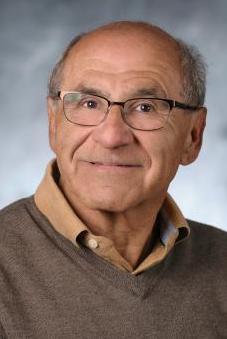A Spectacular Spectroscopy Award

The American Chemical Society has recognized Martin Moskovits, a distinguished professor in UC Santa Barbara’s chemistry department, with the E. Bright Wilson Award. The award recognizes outstanding accomplishments in fundamental or applied spectroscopy.
Science usually advances through the collaborative efforts of large numbers of scientists, often working many thousands of miles apart, Moskovits noted. So the value of your work is ultimately a judgment call by your peer community.
“It’s always nice to get an award that means that some among your colleagues thought your work was worthy of such an honor,” he said.
Spectroscopy investigates how materials interact with visible light and other forms of electromagnetic radiation. Spectroscopic techniques can reveal a great deal about a material’s structure and composition. For instance, the bonds between atoms in a molecule are flexible, “as if they have springs that hold them together,” explained Moskovits.
This means that the molecule has certain vibrational patterns in which all its atoms move with the same frequency — what scientists call a “normal mode.” Researchers can use spectroscopy to identify a molecule’s normal modes, which in turn reveals the molecule’s composition and geometry. Back in 1977, researchers at Northwestern University noticed that some rough surfaces yield a signal six orders of magnitude larger than smooth ones. But nobody knew why. Until Moskovits figured it out.
In college, Moskovits didn’t set out to study spectroscopy. He thought he was studying to become a physicist. “I was actually thinking of majoring in mathematics,” he said, “but when I encountered university level mathematics — i.e. real mathematics — I realized that I could never be a first-rate mathematician.
“And,” he quipped, “it seemed to me that the world simply had no professional space for a mediocre mathematician.”
Fortunately, guidance came early on, in his freshman year. “I had a very charismatic professor, Frank Wetmore, and he told me ‘Martin, you should enroll in a dual major in physics and chemistry, because all of the interesting issues now are at the interface between physics and chemistry.’”
Years later, when he was an assistant professor, Moskovits found himself studying the properties of clusters: collections of bound atoms or molecules between the size of a molecule and a bulk solid. Cluster chemistry considers matters similar to the question “What is a heap?” that philosophers often pose. “Except the difference is that philosophers normally talk about it, whereas we try to measure it,” Moskovits remarked.
Think, for example, about measuring the conductivity of a penny. It doesn’t matter if you take the whole coin or cut it in half: “You get the same value,” said Moskovits, “because conductivity is an intensive quantity.”
You can continue to do this — quarters, eighths, sixteenths — without much ado, but eventually there comes a point at which the property changes dramatically. The “bulk-ness” of the material is an important characteristic up to a certain threshold, explained Moskovits, after which the substance behaves more like a loose conglomeration of atoms and molecules, rather than as a single unit.
While pursuing these topics, Moskovits discovered that electrons behave differently on rough surfaces than they do on smooth ones. “By making a little feature on the surface you open up new ways for the electrons to oscillate and absorb light,” he said. For instance, the electrons trapped in the little lumps and bumps have unique resonances. These oscillations have been dubbed plasmons.
Moskovits realized that these plasmons were responsible for the million-fold increase in the spectrographic signals. “If it enhanced it by five, we wouldn’t be having this conversation,” said Moskovits, “but something that enhances by a million is like magic.” And so it is that Moskovits’ colleagues at the American Chemical Society decided to honor him with the E. Bright Wilson Award.
After making the connection between plasmons and enhanced spectroscopy, Moskovits and many others wondered whether plasmons could enhance other things. “And the answer is yes,” said Moskovits. “You can use the plasmon to enhance chemical reactions.”
The plasmon is an oscillation of electrons, and oscillations stop after a while. However the electrons don’t return to their normal energy right away, and during this excited state they can enter molecules and carry out chemistry, said Moskovits.
For instance, the electrons in a roughened gold rod can split the oxygen and hydrogen atoms in water when energized by sunlight. The plasmons provide the energy required for the reaction without any external voltage applied to the system.
Moskovits challenged his postdoctoral research assistant at the time, Syed Mubeen, to construct just such a water splitter. And it worked the first time, said Moskovits. They published their results in the journal Nature Nanotechnology.
“If you put this in a pond it would burble along producing hydrogen and oxygen without anyone looking after it,” Moskovits said. He hopes to develop the technology to a point where it can be a cost-effective method for producing hydrogen for energy.



